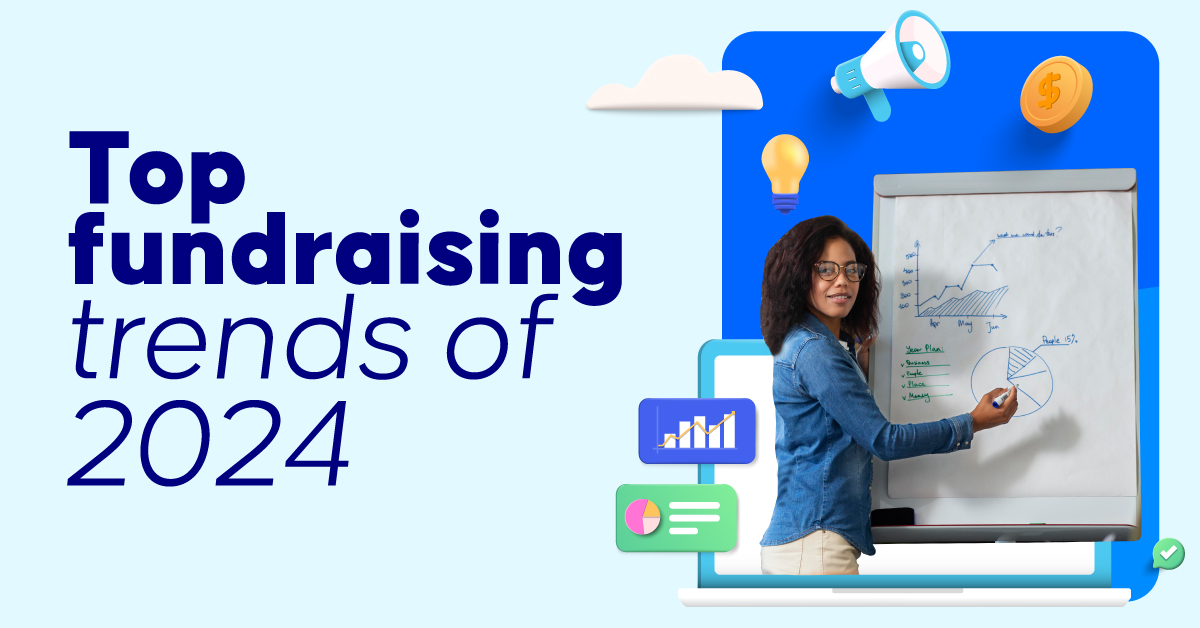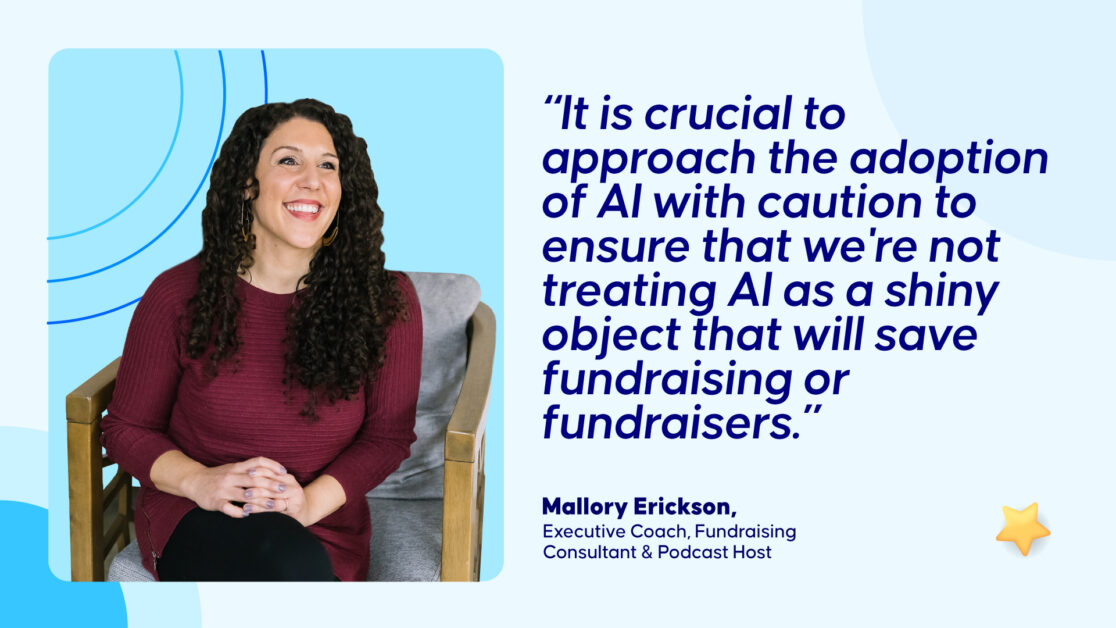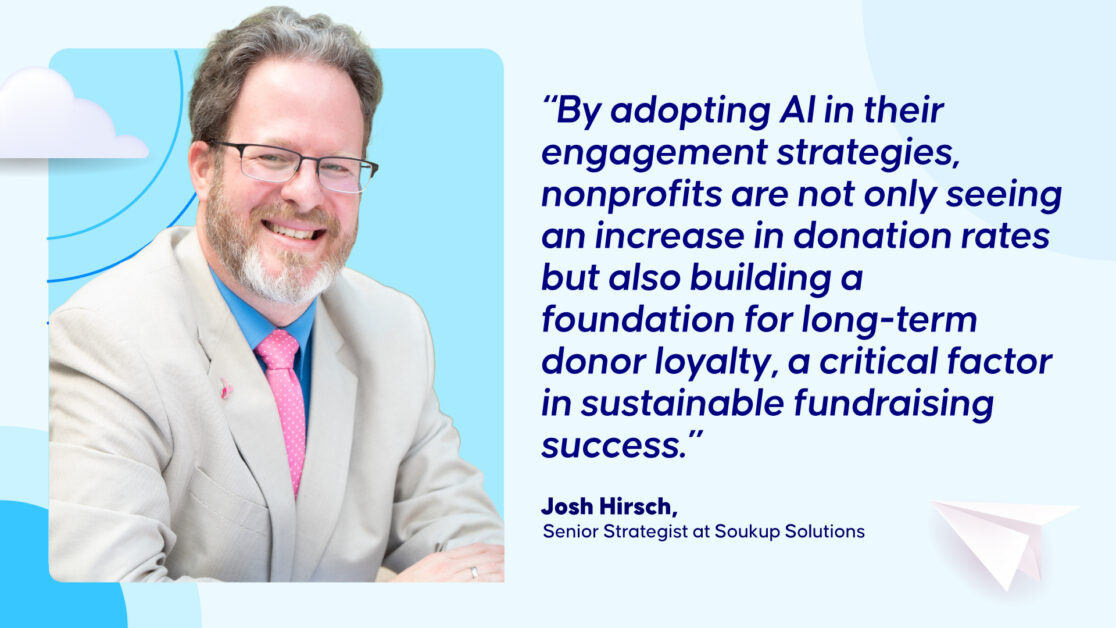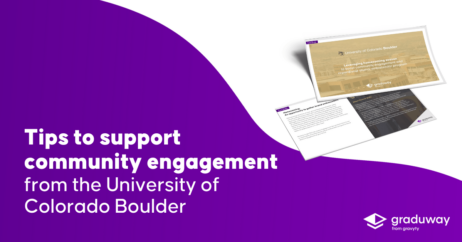What’s trending? Experts reveal the top fundraising trends to embrace in 2024

Fresh off the heels of the whirlwind of year-end giving, fundraisers are faced with a new challenge: staying on top of the emerging trends that permeate the industry. From the growing importance of authentic donor connection and community to the exponential growth of artificial intelligence, fundraisers are gearing up to adjust their strategies to reach goals.
In this article, we explore the top fundraising trends to watch for in 2024—and the strategies to take advantage of them—as identified by leading industry experts.
Aiming for big, bold growth
Nonprofits aiming for significant growth and impact, particularly post-COVID, are setting audacious goals to drive revenue and expand their impact. There’s a shift in mindset against outdated metrics and unrealistic expectations, pushing for substantial investments to achieve transformative change.
Sherry Quam Taylor, CEO of QuamTaylor LLC, expands on this:
“Leaders who come to me with strategic plans in place are ready to make fundamental shifts that will drive revenue by 2X to 10X their current base, to propel the impact they want to make. I’ve seen an increase in capacity building dollars and more investment-level donors willing to invest in general-operating funds. It has put wind in many business-minded leaders’ sails, allowing them to move toward growth.”
Taylor also notes the pushback of leaders today on the old adage of nonprofits doing more with less: “For decades, the nonprofit industry had been held to unrealistic expectations and outdated metrics that kept their organizations from growing. How could anyone change the world or solve huge crises on shoestring budgets? While nonprofits are certainly different from for-profit enterprises in many ways, the fundamental truths of financing remains the same: you can’t do more with less (at least not long term).”
According to Taylor, life-changing missions require a steady and significant investment in resources, tools, and people.
“Donors want to support leaders whose strategic plans and budgets reflect this reality. Donors want to invest in teams learning how to be better fundraisers and effective administrators. These leaders, teams, and organizations are the ones ready to effect the world change we all long to see.”
Diversifying donor engagement
Another trend emerging in the new year is the shift from reliance on big donors to mid-level and monthly donors, with a keen focus on next-gen preferences.
Dana Snyder, Creator of the Monthly Giving Mastermind and Host of Missions to Movements, highlights the importance of diversifying donor engagement:
“There’s been a lot of conversation about the shift of giving within the nonprofit sector. Earlier this year, I had a podcast conversation with Woodrow Rosenbaum, Chief Data Officer at GivingTuesday about what the data was telling us and how it should inform our donor relations,” she says.
“The data highlighted the importance of diversifying donor engagement and the risks entailed in relying too heavily on big donors. Organizations should focus on how to amplify their monthly donor efforts.”
According to Synder, we will likely start to see a recurring first ask as next-gen donors start to permeate the donor base.
“Millennials and Generation Z donors are multi-passionate donors who believe in making an effort to change the world with their time and wallets. They’re also the generations that have grown up as the subscription economy developed with an average of 17 paid media and entertainment subscriptions.”
If nonprofits have a monthly donor program developed that tells a compelling story inviting donors into a community of fellow believers, this won’t just be a trend, it’ll become the new normal of fundraising.
A notable nonprofit trend is that fundraisers may start to lean into the concept of a “subscription for good,” as Snyder calls it.
Relationship-centric fundraising
A nonprofit trend that’s undoubtedly poised to continue and grow in its importance to fundraising strategies is relationship-centric fundraising. Genuine connections, hyper-personalization, and prioritizing donor relationships over transactions will continue to play a key role in 2024 fundraising.

Sabrina Walker-Hernandez, President & CEO, Supporting World Hope, says that a significant shift is underway, one that emphasizes the power of connection.
“Picture this: 60% of successful fundraising depends on genuine relationships, not just transactions. It’s the cornerstone of success in 2024,” Walker-Hernandez says.
“Imagine crafting experiences that leave your special few utterly amazed. It’s not about the size of the group; it’s about the profound impact you can create within it. By surprising them, you might just discover delightful surprises yourself.”
Walker-Hernandez says it’s time to redefine fundraising, focusing teams and boards on relationships over transactions.
Continuous donor engagement and leaning into innovation
While attracting new donors has always been a key measure of success to fundraising organizations, donor retention is emerging as crucial for sustained success.
Lynne Wester, Principal & Founder, The Donor Relations Group, points to cultivating long-term donor relationships through authentic connection and appreciation to build a strong donor retention strategy.
“Effective communication plays a central role, with personalized updates on how their contributions are making a tangible impact,” says Wester.
“Nonprofits that actively engage donors beyond soliciting contributions, such as through regular stewardship reports, personalized acknowledgments, and exclusive insights into the impact of the donors’ generosity, are more likely to retain their supporters.”
Creating a seamless and positive donor experience, from the ease of contributing to transparent use of funds, builds trust and loyalty.
Another, more troubling trend Wester sees in the nonprofit sector is a lack of effective leadership in fundraising, impacting strategic direction, technological adaptation, and fundraising innovation.
“Many organizations face difficulties in cultivating visionary leaders who possess the strategic acumen necessary to navigate the complex landscape of nonprofit fundraising. The absence of strong leadership often translates to a lack of clear direction, inhibiting the ideation and execution of robust fundraising strategies. This deficiency becomes particularly pronounced when it comes to harnessing innovative technologies, embracing evolving donor trends, and adapting to dynamic economic conditions.”
Without adept leaders who can inspire confidence, mobilize teams, and engage with donors, nonprofits may struggle to build sustainable funding streams. Addressing this leadership gap will be critical to ensuring the long-term viability and success of nonprofits in the years to come.
The responsible adoption of AI in fundraising
It’s no secret—AI is everywhere, and it isn’t going away any time soon. Fundraising is no exception. With the exponential growth of AI in fundraising processes, responsible adoption will play a key role in the year ahead.

Mallory Erickson, Executive Coach, Fundraising Consultant & Podcast Host talks about this fundraising trend and cautions against blind adoption of AI integration, advocating for identifying organizational challenges before implementing a solution.
“The idea of AI taking some weight off fundraisers’ shoulders is super appealing. However, it is crucial to approach the adoption of AI with caution to ensure that we’re not treating AI as a shiny object that will save fundraising or fundraisers,” says Erickson.
“Shiny object syndrome in nonprofits can lead to the blind adoption of tools and technology without considering the specific needs and challenges faced by organizations. As the AI market becomes saturated with technology vying for a piece of the AI scene, it is crucial to avoid treating AI as a cure for all fundraising challenges.”
Erickson recommends these three steps for for fundraisers considering an AI solution:
- Begin by identifying the most significant challenge(s) to address, like donor prospecting, fundraising systems, automation, etc.
- Once the challenges are identified, the next step is to explore the tools available, including but not limited to AI, that can effectively address these issues.
- If AI is a part of those tools, ensure the ethical and responsible use of AI (check out fundraising.ai for a helpful framework on the responsible use of AI in fundraising).
The aim isn’t just to jump on the AI bandwagon. Nonprofit leaders should focus on nailing down and solving their main issues, and AI might just be one piece of that puzzle.
AI-driven personalization
With the above in mind, AI will undoubtedly play an increasing role in donor engagement moving into 2024 and beyond. Fundraisers will leverage AI technologies to reach donors at scale and in more effective ways through personalization, data analysis, and enhancing the overall donor experience. However, as discussed in the previous trend, treating AI as a universal solution to donor engagement without addressing specific organizational needs will likely hinder fundraising efforts.
Josh Hirsch, Senior Strategist at Soukup Solutions, breaks down AI’s growing effect on donor engagement strategies.
“AI-driven personalization offers a new level of sophistication in how nonprofits interact with their donors,” says Hirsch.
“By leveraging AI, organizations are now able to analyze vast amounts of donor data – including past donation history, communication preferences, feedback sentiment, and engagement patterns – to tailor their fundraising appeals and communications. The result is a more engaging, relevant, and impactful communication strategy that not only captures the attention of potential donors but also strengthens the bond with existing supporters.”
According to Hirsch, this AI-tailored approach is revolutionizing the world of donor relations, and allows nonprofits to move beyond the one-size-fits-all model, instead delivering content that is uniquely relevant to each donor.

AI-driven personalization also extends beyond just fundraising appeals; it encompasses the entire donor journey, including personalized acknowledgments, updates on how donations are being used, and invitations to events that align with a donor’s interests.
“By adopting AI in their engagement strategies, nonprofits are not only seeing an increase in donation rates but also building a foundation for long-term donor loyalty, a critical factor in sustainable fundraising success.”
Generative AI in annual giving
With the ever-expanding use cases for AI in fundraising, potential applications for annual giving teams such as content creation, data analysis and segmentation are trending up in 2024.
Julie Knight, Ph.D., Executive Director of Annual Giving, Carnegie Mellon University, expands upon this annual giving trend:
“The major transition will be including generative AI within the professional realm on a regular basis to increase efficiency and gain new insights. In the annual giving space, there are multiple use scenarios ranging from content creation to smart segmentation, soliciting donors with personalization at scale.”
Knight breaks down emerging use cases for generative AI for annual giving teams:
- Content creation—Using generative AI for first drafts of alumni email or strategy outlines can be a great tool to avoid starting at a blank page and support ideation. As always, be sure to fact check and review prior to deployment.
- Donor data analysis and segmentation—Gain insights on donors as well as making data analysis more accessible for reporting and smart segmentation. A variety of systems exist that support this option and annual giving teams are starting to integrate them into their business practices.
Knight emphasizes that with all AI usage, it’s always important to consider data security and proprietary data within organizational and fundraising processes.
Leveraging AI for nonprofit community building
AI as a tool for fostering community is also emerging as a nonprofit trend for organizations going into 2024. AI-powered tools can enable fundraisers to enhance and scale personalized outreach.
Michelle Flores Vryn, CFRE, Social Impact Consultant, highlights the benefit of AI when leveraged as a means to create more meaningful connections and augment human efforts rather than replace them.
“In this era where AI is skyrocketing, there’s a parallel trend that’s equally compelling: our growing sense of social isolation,” says Vryn.
The Wall Street Journal headline about “the loneliest generation” underscores a societal crisis—people, especially younger generations, are increasingly isolated and in search of a sense of belonging. In fact, 73% of Gen Z reported feeling alone sometimes or always, and 51% of Millennials reporting the same.
Community—Vryn says—is the antidote to isolation.
“How do nonprofits build community? They do so by understanding the value produced by the mission, programs and services provided. They create conditions for people to voluntarily say, “yes, I want to be a part of this!”
If your nonprofit is looking to enhance its digital presence and supporter base, 2024 is the year to leverage AI and make this happen. AI will allow nonprofits to become more human with their network of supporters, enabling more capacity for fundraising segmentation and personalized outreach. It can help streamline work to create interactive content and consistent social media posts.
Fundraising trends for success in 2024
As we step into 2024, fundraisers will be faced with new challenges—economic uncertainty, global and environmental turmoil and evolving donor preferences will force teams to make changes to long standing processes and face tough realities. But on the flip side, 2024 will present plentiful opportunities to make an impact through exciting new trends and technologies that foster community, build authentic relationships, and do more good.




